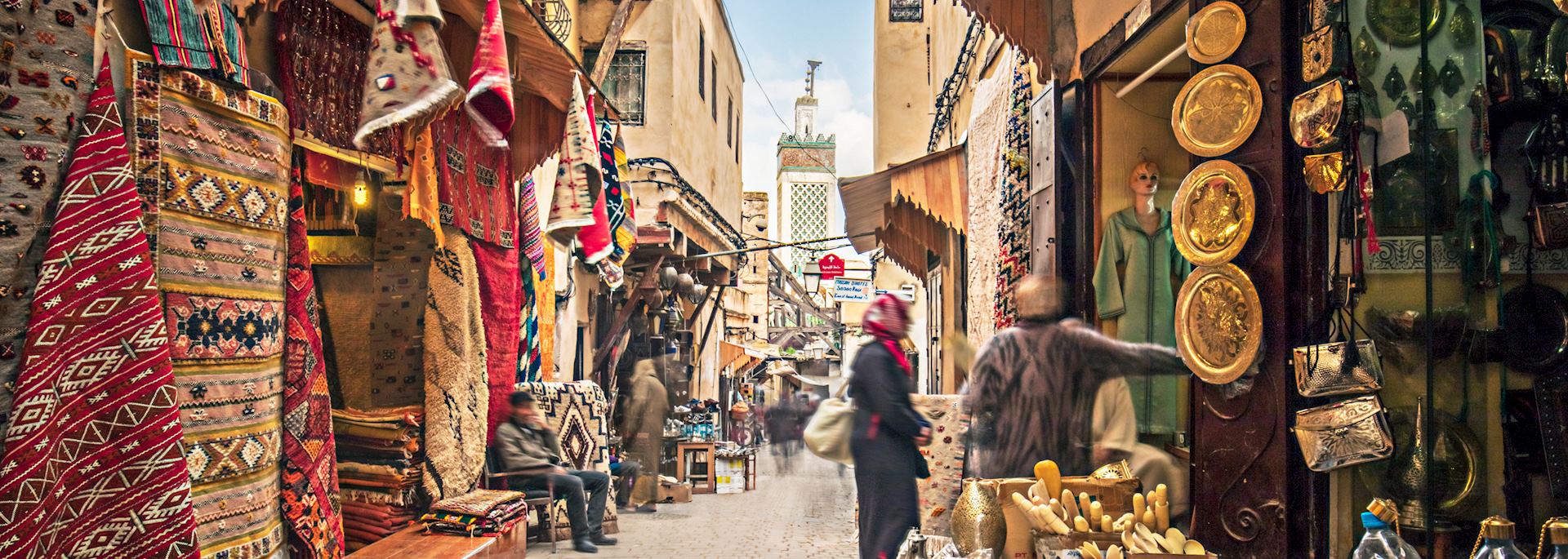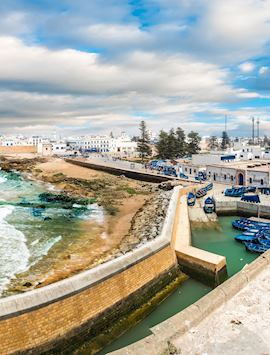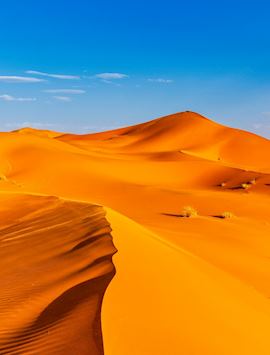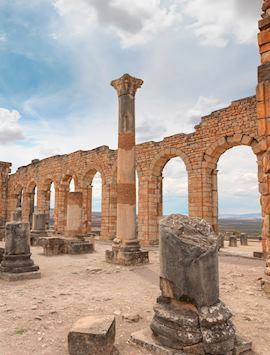By Morocco specialist Kerry-Ann
I lived in the medina of Fez for years, but I still need to brace myself before I enter any of Morocco’s souqs.
Merchants call to you in half a dozen languages, donkeys bray, lanterns sway in the breeze and the scents of baking bread and ground spices mingle with the less pleasant aromas of the tanneries and butchers. The stalls and shops are tightly packed with goods: a rainbow of hundreds of shoes, thousands of brightly patterned rugs, a wall filled with intricately painted pottery.
When you visit a Moroccan souq, you discover a way of life that hasn’t changed very much for centuries.
Inside the medinas
Souqs are always located in cities’ medinas, the old walled section that predates the French occupation. Dating back more than 1,000 years, these areas are densely packed with whitewashed buildings, built in a jumbled layout that creates a veritable labyrinth — Fez has more than 9,000 streets, many of them too narrow for two people to walk abreast. Furniture in medinas is often moved over roof terraces, passed from one building to another because it’s too big to fit down the tiny lanes.
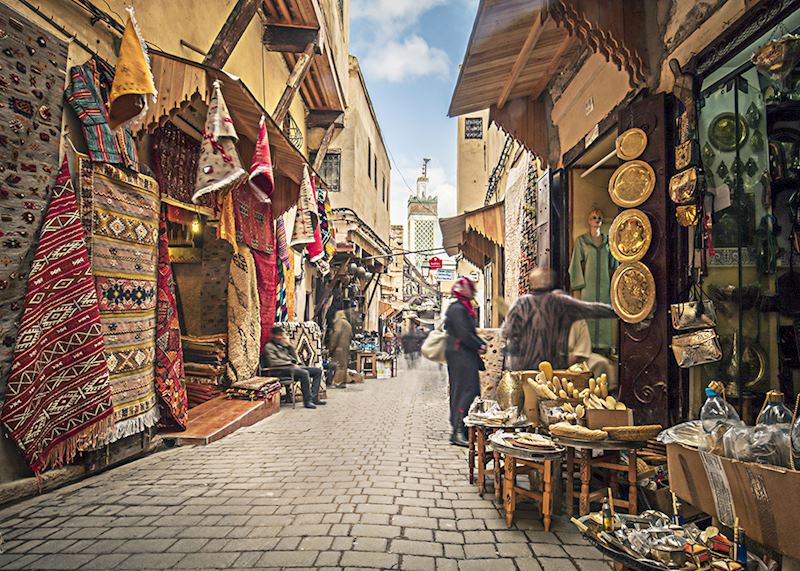
For obvious reasons, cars are largely excluded from the medinas. Instead, mules are a common sight, laden with oversized panniers that contain everything from bags of flour to cans of diesel. Drovers call ‘Belak! Belak!’, as a warning for pedestrians to make way.
You enter the medina on foot through one of the many gates, or babs. The babs are notable landmarks, playing a vital role in cities where the street names are considered entirely optional. My apartment in Fez was near Bab Boujeloud. It’s known as the Blue Gate in English because its exterior-facing side is densely ornamented in cobalt-blue calligraphy and floral motifs. However, the interior is predominantly green, venerating the prophet Muhammad and Islam.
The medina is divided up into small, loosely defined districts, each of which has six vital institutions: a mosque, a madrasa (school), a hammam (bathhouse), a faran (baker), a hanout (general store) and a fountain where you’ll see locals filling containers for their daily use.
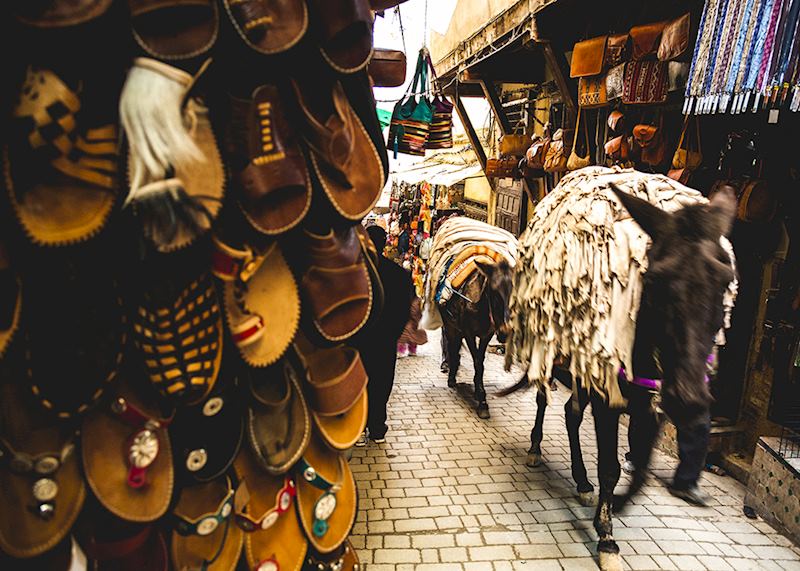
How to buy a rug
Buying a rug in Morocco is a serious business, one that cannot be taken lightly or rushed. If you’d like to buy a rug, I’d plan to spend at least two hours in the negotiation process and bring both a good sense of whimsy and a strong bladder.
With rugs hanging from the walls and overhead, these are perhaps the most photogenic of the many souq shops. They’re usually the largest, too. You enter via a narrow doorway (hung with more rugs) and emerge into a huge space (by medina standards) with folded rugs lining the walls. When the proprietor catches your eye and greets you with ‘ssalamū 'lekum’, you’ll begin a ritual dance that dates back hundreds, if not thousands, of years.
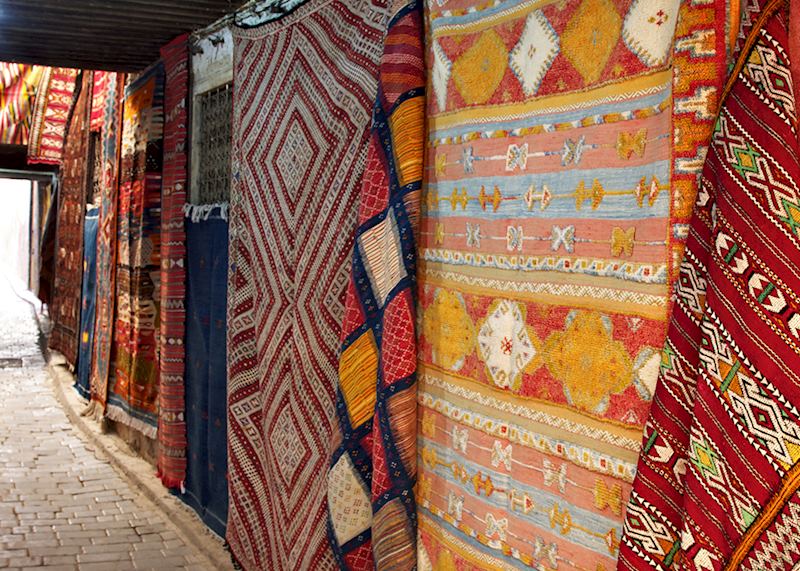
First, the proprietor will determine what you’re looking for. This is important because you have a mind-boggling array of options from which to choose. Many of the rugs are made on looms in the city, hand-tied in a meticulous fashion. But many more, the most desirable ones, are made by the Imazighen who live in the mountains.
You can usually work out if a man or woman made the Amazigh rug by how elaborate the designs are. The men’s rugs are simple while the women create elaborate works of art. More than just decoration, however, the geometric patterns are examples of the Amazigh written language and often tell stories. Some of the rugs are double-sided, with a flattish summer side and a winter side that boasts a longer pile.
Once he has a sense of what you’re looking for, you’ll be seated and a vast parade of options will begin. The merchant and his assistants will whisk out rug after rug and ask for your opinion. Too busy? This one is simpler. Do you want a more vibrant red or a softer yellow? How thick would you like it?
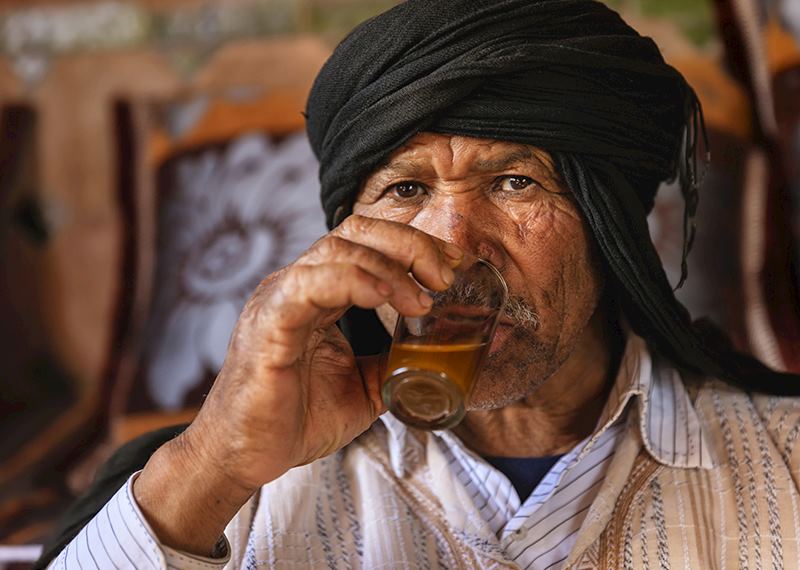
As you winnow down the selection, you’re served as many cups of mint tea as you can drink. Actually a mix of gunpowder tea and huge bunches of mint, it's usually served shockingly sweet. The proprietor will pour it into your cup from very high up, dump the tea back into the pot, and then pour it again. This serves the dual purpose of mixing the tea and warming the cup.
Drinking gallons of tea and sorting through the shop’s inventory to find your perfect rug will take time. Once you do find the right one, ask for the price. Then the haggling begins.
You’ll find that you get a better price if you engage in the process yourself, even if you have a guide providing interpretation. Learning a few snippets of Arabic will also help. There will likely be pauses in the dickering process for more tea and small talk. As you and your seller learn more about each other, the price will come down, slowly and steadily.
The price range varies hugely depending on what you’re considering. You can spend tens of thousands of dirham on a large antique carpet or just a few hundred on a newer, smaller rug. In the end, you’re aiming for just under half of the initial offer.
The negotiation process is similar in most of the other craft souqs, though in my experience somewhat less intense.
Browsing the leather souqs
Racks and rows of shoes, bags, jackets and similar goods populate the leather souqs. There are a wide array of options, of differing quality, from fashionable jackets that wouldn’t be out of place in a chic Parisian party to pointy-toed babouche slippers, their construction unchanged for centuries. As well as the more common cow leather, you’ll also find wares made from goat and camel leather.
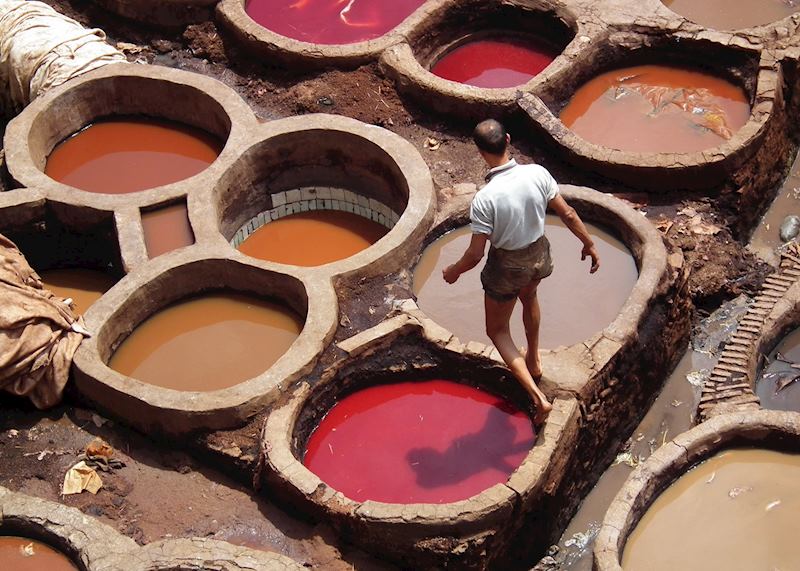
If you’re interested, you can ask to see the production area. The shopkeeper will take you out back onto a viewing platform high above the yard, which buzzes with activity.
The dye pits look like giant paint pots, some of them dating back more than 1,400 years. All the dyes are from natural sources — henna for the red, indigo for the blue — some so bright that they seem to glow under the relentless sun. You’ll also see the tanneries where rawhides are cured with pigeon guano, the pits’ walls covered in a thick white paste.
As you might imagine, the smell can be eye-watering. If you want to see the leather tanners and dyers, I suggest visiting early in the morning, before the heat of the day makes the stink unbearable. Most shop owners will offer you a bunch of fresh mint to hold over your nose.
Buying pottery and tiles
Fez is known for its pottery, and even in the other cities you’ll find the bottom of many pieces marked with ‘Fes’ — its Moroccan spelling.
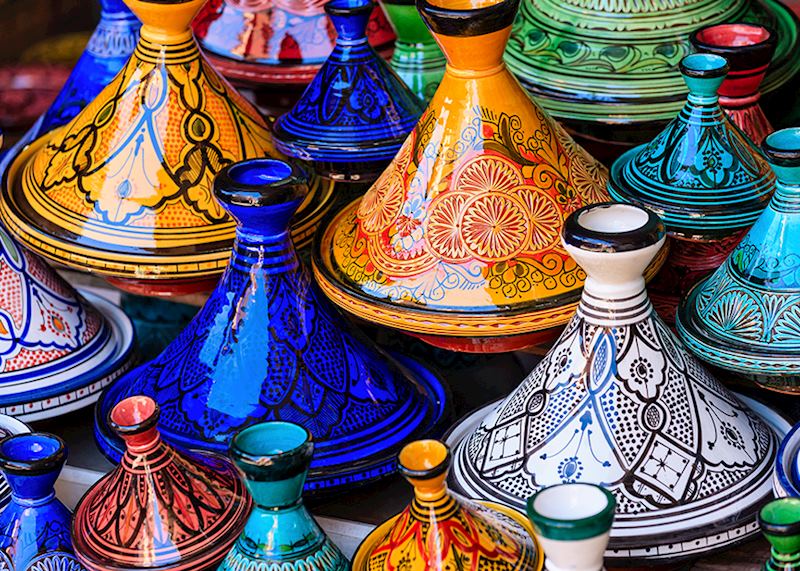
Glazed white, Fez ceramics are usually covered in complex geometric patterns of blue (for Fez) or green (for Islam). The designs are created with a fine horsehair brush, each painstakingly painted by hand. The kilns are fired with olive seeds, a renewable resource that burns hot enough to fire the ceramics but gives off little smoke.
Along with the usual tableware, you’ll find zellij. These tiny tiles are used in the intricate mosaics that feature throughout the country on mosques, madrasas, fountains, tabletops and the great gates of the medinas themselves. Their shapes — from simple squares to fanciful 10-pointed stars — are hand cut after firing. The craftspeople use hammer and chisel to hew them from a larger slab of ceramic, working with a speed and delicacy that is astounding to watch.
Other souqs to visit
In the copper and bronze souq, the air rings with the sound of hammers beating out platters, bowls and tureens. Some are highly decorated and others are plain. You can buy elegant tea sets or enormous copper cauldrons fit for Macbeth’s witches.
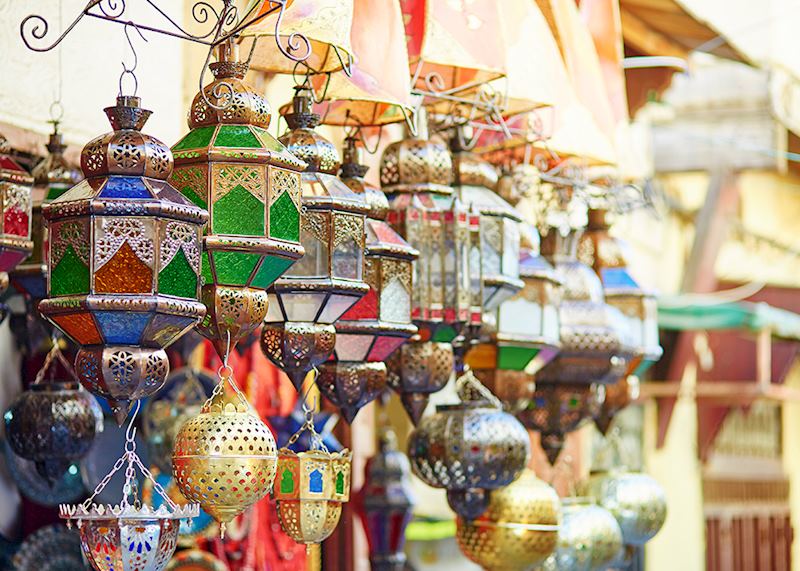
I like to visit the lantern sellers at night, when their stalls literally shine with heavily hung wares. You can find all-metal lamps, pierced in complicated abstract designs that let the light shine through. There are also glass ones, from simple clear-glass rectangles to complex stained-glass globes. And, you can find options that combine the two, with delicate metal filigree over the red or blue glass.
The textile merchants offer a wide range of goods, from mass-produced kaftans to handwoven fabrics. If a rug is too much of a commitment, you can pick up a bright striped throw or patterned pillow to take home.
Silversmiths create a wide array of goods, from simple bangles and necklaces to wide cuffs that have been heavily engraved and studded with cabochon semi-precious stones. Here, too, you can find platters, tea sets and bowls, though you’ll pay more than in the copper souqs.
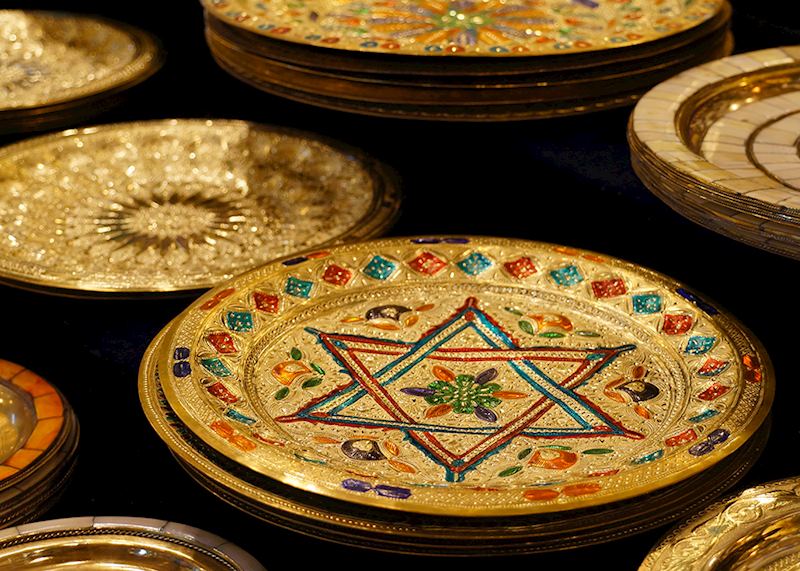
If you’re interested in gold you should visit the Jewish quarter, known as the mellah. There’s one in every major Moroccan city. Goldsmith shops tend to congregate in the mellah, dealing in elaborate necklaces, heavy bracelets and large rings. Whether you’re looking at silver or gold, a reputable dealer will always weigh any piece to help establish a price.
There are also plenty of stalls selling less-expensive options, like strings of cobalt-blue beads, silver-plated pendants, simple bangles and bracelets strung with huge nuggets of amber.
There is a near-endless list of other things you can buy. Herbalists will pound leaves and steep flowers to create folk remedies. Women sitting next to piles of green powdered henna will draw designs on your skin. Woodworkers sell everything from cups to furniture sets made from fragrant cedar. If the desert air has dried your skin, you can buy a curved bottle filled with pure argan oil or for a few dirham the glistening black soap made from olive skins, known as sabon beldi.
The food souqs
The souqs that sell food are usually located closest to the babs, to make it easier to transport the goods from the outer city. Merchants stand behind tables crowded with piles of seasonal fruits and vegetables — pomegranates in winter, strawberries in spring, mounds of ruby-red cherries in summer. You’ll also come across smaller outfits, like a single man sitting on a stool and selling bunches of fresh coriander or mint from a basket by his feet.
There are handwoven baskets piled high with mounds of grain, huge white bowls with pyramids of olives and bags full of grain. If you have a sweet tooth, there are stalls filled with carefully formed pastries that glisten with a glaze of honey, as well as huge rounds of pressed, dried figs hanging on the walls.
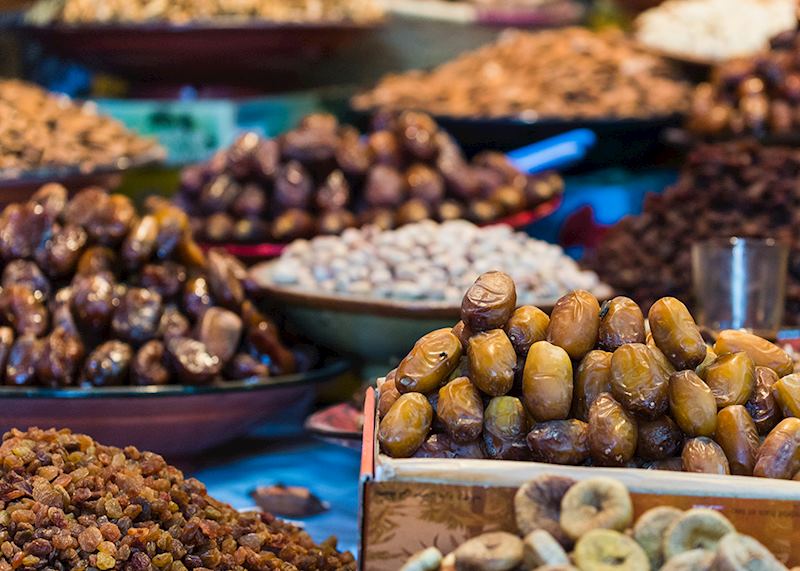
The meat souqs are, perhaps, not for the faint of heart. Turkeys scratch at the dirt, and pigeons and rabbits wait in cages for the dull thwack of the butcher’s knife. Beef vendors display whole sides of cows hanging from enormous hooks, with smaller cuts kept in mammoth refrigerators that date back to the Cold War, their heavy doors opened with huge chromed handles. Reputable camel butchers are easily identified by the camel head mounted outside the stall, usually with giant bunches of coriander tied to its nose.
Probably the most fragrant and beautiful area is the spice souqs. Ground golden turmeric and rusty-orange paprika are piled high in baskets and bundles of cinnamon and feathery mountains of rose petals fill the air with a sweet scent.
I love buying my spices in Morocco. They’re much more pungent than those in the dusty bottles I find on supermarket shelves, as well as cheaper.
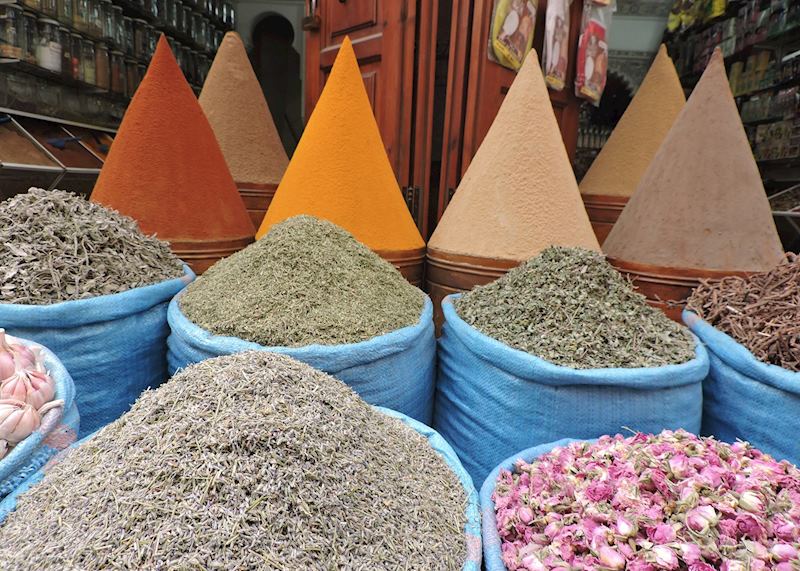
Saffron, in particular, is more affordable here. I also like to buy ras el hanout, literally ‘head of the shop’. A blend of at least 12 spices, it differs from shop to shop but usually features cardamom, ginger, clove, and allspice, among many others.
Honey is a common ingredient, especially in Moroccan pastries, and the honey souq is a popular place for locals. The air buzzes with bees from the surrounding countryside, drawn by the golden sweet smell. Giant blue barrels are filled with gallons and gallons of honey.
You can buy wild honey that is still so raw it has bits of comb and dead bees in it, or more refined options scented with mint, roses or orange blossoms. You buy honey by the weight, measured in careful drops into plastic containers that are set on giant, old-fashioned scales.
Food souqs aren’t the place to exercise your haggling skills. Prices are fairly standard across the medina and very inexpensive.
Start planning your trip to Morocco
Start thinking about your experience. These itineraries are simply suggestions for how you could enjoy some of the same experiences as our specialists. They're just for inspiration, because your trip will be created around your particular tastes.
View All Tours in Morocco
